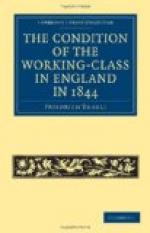We have already seen in the introduction how the population employed in working up the textile materials were first torn from their former way of life. It is, therefore, not surprising that the progress of mechanical invention in later years also affected precisely these workers most deeply and permanently. The history of cotton manufacture as related by Ure, {134a} Baines, {134b} and others is the story of improvements in every direction, most of which have become domesticated in the other branches of industry as well. Hand-work is superseded by machine-work almost universally, nearly all manipulations are conducted by the aid of steam or water, and every year is bringing further improvements.
In a well-ordered state of society, such improvements could only be a source of rejoicing; in a war of all against all, individuals seize the benefit for themselves, and so deprive the majority of the means of subsistence. Every improvement in machinery throws workers out of employment, and the greater the advance, the more numerous the unemployed; each great improvement produces, therefore, upon a number of workers the effect of a commercial crisis, creates want, wretchedness, and crime. Take a few examples. The very first invention, the jenny, worked by one man, produced at least sixfold what the spinning-wheel had yielded in the same time; thus every new jenny threw five spinners out of employment. The throstle, which, in turn, produced much more than the jenny, and like it, was worked by one man, threw still more people out of employment. The mule, which required yet fewer hands in proportion to the product, had the same effect, and every improvement in the mule, every multiplication of its spindles, diminished still further the number of workers employed. But this increase of the number of spindles in the mule is so great that whole armies of workers have been thrown out of employment by it. For, whereas one spinner, with a couple of children for piecers, formerly set six hundred spindles in motion, he could now manage fourteen hundred to two thousand spindles upon two mules, so that two adult spinners and a part of the piecers whom they employed were thrown out. And since self-acting mules have been introduced into a very large number of spinning-mills, the spinners’ work is wholly performed by the machine. There lies before me a book from the pen of James Leach, {135} one of the recognised leaders of the Chartists in Manchester. The author has worked for years in various branches of industry, in mills and coal mines, and is known to me personally as an honest, trustworthy, and capable man. In consequence of his political position, he had at command extensive detailed information as to the different factories, collected by the workers themselves, and he publishes tables from which it is clear that in 1841, in 35 factories, 1,060 fewer mule spinners were employed than in 1829, though the number of spindles in these 35 factories had increased by




